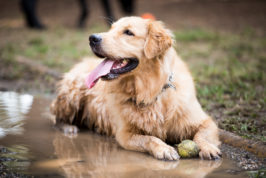Hydrotherapy is something that we know can be beneficial for people. It’s a low-impact and low-intensity way of exercising, and it helps to improve muscle strength. But did you know that it can be a great way of helping our canine friends, too? Dr Rebecca MacMillan is here to explain the benefits.
What is dog hydrotherapy for dogs?

Dog hydrotherapy is a type of water-based physiotherapy that can be used for a number of reasons. Most dog owners will explore hydrotherapy when their pet has a health condition that could benefit from low-impact exercise and muscle-strengthening techniques. This is something that swimming with a trained canine hydrotherapist can provide.
Dog hydrotherapy can also be useful for healthy dogs, as a way of building muscle condition, improving fitness and helping to provide an alternative form of exercise in a way that doesn’t put as much strain on joints. And many dogs really enjoy it!
As with people, dogs will become buoyant in water, which supports their body, meaning there’s less impact on the joints than with running or exercising on hard ground.
There are different types of canine hydrotherapy:
- Treadmill therapy – a treadmill is set in a tank, and the water level filled to suit the height of the dog, so that he or she can walk comfortably with the water coming up to the lower chest area. This allows your dog to not only be given some buoyancy while exercising, but also to provide gentle resistance to their movements (a way of helping strengthen muscle). This type of hydrotherapy is often used in dogs suffering from conditions like Osteoarthritis, or other joint issues.
- Whirlpool therapy – warm jets of water are used in a pool to target specific muscle injuries and give relief to aches and pains.
- Dog pools – dog swimming pools are used to provide controlled swimming exercise, with a therapist that stays beside them throughout. Floats and life jackets are used to help give your dog extra support in the water. Swimming is an excellent way of exercising without impacting sore joints.
Which conditions can dog hydrotherapy be used for?
Hydrotherapy is much more than just letting your dog have a splash about, so the same effects are unlikely to be achieved just by taking your dog to the sea or river for a dip. Trained physiotherapists will target exercises specific to your dog’s condition or injury. They will be carried out in warm water, and in such a way that the dog is unlikely to accidentally cause itself more damage.
The following are examples of conditions that can benefit from hydrotherapy treatments:
- Joint disease – Osteoarthritis, Hip Dysplasia, Elbow Dysplasia, Spondylosis and Patella Luxation
- Post-surgery rehabilitation – hip replacement, cranial cruciate ligament surgery, Arthroscopy and Patella Luxation
- Neurological conditions – spinal injuries, Degenerative Myopathy, Intervertebral Disc Disease, Neuromuscular Disease and peripheral nerve issues
- Muscular injuries – strains and sprains, ligament injuries
- Obesity – hydrotherapy can be a useful exercise program in conjunction with a weight-loss diet
If you’re not sure whether hydrotherapy is suitable for your dog’s condition, speak to your vet for advice.
How can hydrotherapy help your dog?

Regardless of the condition being treated, there are many benefits of hydrotherapy for pets. I’ll talk through them below…
Improving muscle tone
Muscle tone and mass is improved without causing undue impact to joints. Hard ground causes concussive effects to the joints, whereas exercising in water stops this degree of impact, making exercise safer. Improved muscle mass provides better support to diseased or injured joints.
Faster tissue healing
Warm water and gentle exercise improves blood flow to areas of damage, encouraging faster healing and a reduction in swelling.
Improved range of motion
Animals can move their joints more freely when supported by water. Those with stiff joints have a greater range of motion in water than they do on land.
Improved fitness
Hydrotherapy is a good form of exercise, because the water provides some resistance which the dog has to work against. Not only will this strengthen muscle, but it will also give them a cardiovascular workout, getting their lungs and heart to work harder, too.
Faster rehabilitation
Animals that have been on strict rest post-surgery will experience muscle wastage (atrophy) which hydrotherapy can help with. Targeted exercise with a trained professional can get your dog back up to fitness quicker than you may achieve through measures at home.
Many dogs take pleasure in hydrotherapy, as the warm water can help improve pain and stiffness and the endorphin release makes them feel good. Lots of dogs enjoy being in water, so it can be a real treat for them to have a regular swim – especially if they’ve been on restricted exercise!
Anything I need to watch out for when it comes to dog hydrotherapy?
You’ll need to speak to your vet to find out if hydrotherapy is likely to be useful for your pet. Most hydrotherapy centres will require your vet to fill out a referral form, which is a simple document stating your pet’s medical complaint, and whether they’re happy for them to partake in this treatment.
If your dog is attending hydrotherapy post-surgery, you’ll need to wait until they’re completely healed and deemed fit to exercise by your vet. Depending on the surgery, this may be after they’ve had their post op x-rays taken, which could be six or seven weeks post-surgery.
Any form of exercise or physiotherapy carries a degree of risk. Some injuries could behave unpredictably and get worse rather than better – though this is rare. The hydrotherapy centre will be able to advise you on this.
Most dogs take to hydrotherapy well, but some animals may be fearful of water or have an aggressive/un-handleable temperament which could make them harder to work with safely in the water. If you’re not sure, speak to both your vet and the hydrotherapy centre for advice about whether your dog is a suitable candidate.
One final point is to check your insurance policy. Some pet insurance companies will happily cover complementary therapies, but others may not. So, find this out in advance to help manage your expectations in terms of costs.
How do I find a dog hydrotherapist?
When choosing a canine hydrotherapist, make sure they’re a member of the Canine Hydrotherapy Association which has strict quality standards that must be adhered to. This will help give you confidence in the service you’re paying for. A list of canine hydrotherapists is also held on the NARCH website (National Association of Registered Canine Hydrotherapists).
It’s worth asking your vet if they have any recommendations of local centres, as they may have a good working relationship with them.
Always follow your vet’s advice with regards to treatment for your dog. Most dogs do best with a combination of traditional medications (such as a non-steroidal anti-inflammatory drugs, or other pain killers) in conjunction with a weight-controlled diet, and complementary therapies such as joint supplements, hydrotherapy or physiotherapy.
Conclusion
Canine hydrotherapy is a great low-impact exercise, ideal for dogs with a variety of muscular or orthopaedic conditions. There are numerous benefits, but you should always look to your vet for treatment guidance. Above all, hydrotherapy should be enjoyable for all parties, so make sure you choose to attend a qualified centre and that your dog likes going to the sessions. Happy splashing!




